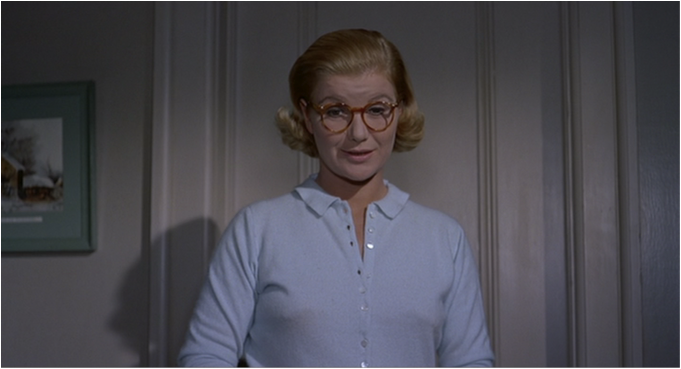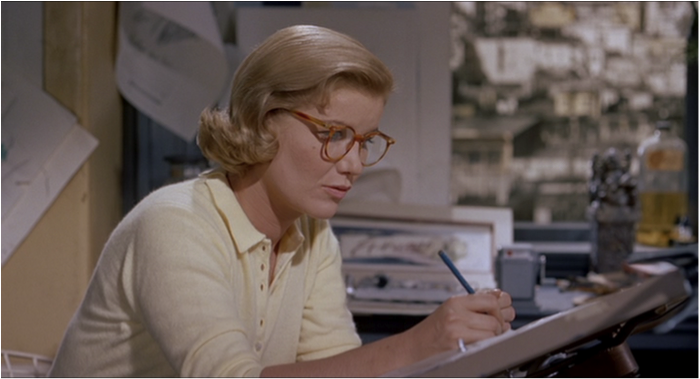Every month the Sound On Sight staff bands together to tackle a specific filmmaker, event and/or some sort of movie related theme. This month our focus shifts towards the “Master of Suspense”, Alfred Hitchcock.
****
Much has been written about the male gaze in Alfred Hitchcock’s 1958 masterpiece, Vertigo. Laura Mulvey’s seminal essay “Visual Pleasures and Narrative Cinema,” notes that the male gaze dominates Hitchcock’s work, forcing the viewer to see through the eyes of the heterosexual male (Jimmy Stewart’s Scottie, in this case) as he fetishizes and objectifies Kim Novak through his point-of-view and Hitchcock’s camera.
The famous “following” scene, where an enamored Scottie follows the object of his investigation and desire, Madeleine (Novak) lasts for 12 minutes and 40 seconds.
Later, when Scottie plays Pygmalion and attempts to remake Judy (Novak again) in Madeleine’s image, the audience is again relegated to his perspective for nearly a full 10 minutes.
It’s this latter section that really hits Mulvey’s point home. Though it occupies less screen time than the former, Hitchcock’s camera is more sexually charged and voyeuristic – actively exploring Novak’s body, complete with extreme close-ups of eyes and nails in the salon and feet in the shoe store. This scene culminates in a neon-saturated, hazily shot denouement with a dizzying 360-degree dolly around the kissing couple.
There aren’t many major characters outside of Scottie and Madeleine/Judy in Vertigo. Gavin Elster (Tom Helmore) is the inciter of the entire situation and Midge (Barbara Bel Geddes) is Scottie’s former lover and current friend, still head over heels for him. Of these, it’s Midge who is “granted” the secondary gaze in the film, though hers is significantly limited.
If Scottie’s gaze, as Mulvey so thoroughly dissects, lusts after Madeleine and Judy, Midge’s gaze, though sparsely used in the film, desires Scottie. This is not to say that Midge’s gaze controls the film. Screen time alone would contradict that argument. Nonetheless, Midge represents a counterbalance to Scottie. Where Scottie’s gaze is sexual, lustful, and fetishizing, Midge’s is motherly, melancholy, and jilted. Both gazes equate to a kind of love, however it is only Scottie’s gaze and love that leads to mania (a very different kind of vertigo than his literal acrophobia). Midge’s love leads to rejection and, as I’ll demonstrate, Hitchcock goes out of his way to avoid utilizing Midge’s POV in any traditional or sexual way.
There are three key places where we get Midge’s gaze. The first, and most frequent, is in her apartment. The second is outside of Johnny’s apartment. The third is in the hospital after Madeleine’s death.
The first POV we get from Midge is a simple one. At her drafting table, Midge looks down at her drawing. It’s of a woman in a brassiere. In the majority of the subsequent shots in this scene, Hitchcock is careful to place the camera at a neutral side angle when on Scottie, rather than at Midge’s position.
There is a second series that comes very close to functioning as a POV. It occurs right after Scottie tells her, “Now Midge, don’t be so motherly.” The cut to Midge is the first close-up of her in the scene. She looks up and over to Scottie:
The next cut is to Scottie, and we get him as Midge sees him. He’s in a medium wide-shot. This is far from the exploratory, male gaze that Mulvey discusses. Midge doesn’t examine Scottie, she sees as much of the room as she does him:
This POV ends as Hitchcock cuts back to Midge in a medium-shot. This all comes at a key moment in Midge’s character development (motherly) and is clearly representative of a major cause of her anxiety:
The next POV is when Scottie attempts to climb the step-ladder to battle his vertigo. Though this short sequence is comprised of both Scottie and Midge’s POVs, Hitchcock pulls a nice trick at the end.
Midge watches Scottie climb the ladder:
This is followed by her gaze:
The pattern repeats:
But as Scottie experiences vertigo, the angle changes. We’re no longer looking from Midge’s POV here. This is a neutral angle, on the same level with Scott and not looking up at him:
Back to Midge, and Hitchcock again establishes the POV, as the shot after Midge looking is again down from her perspective:
Here’s where Hitchcock pulls his trick. Scottie begins to collapse. It’s a powerful moment for Midge – she watches the man she loves fall. She holds the power. We see this through her eyes. But Hitchcock undercuts this by pulling the camera back as she falls, revealing the shot to be objective, rather than through her eyes. The two frames below represent, along with the one directly above, one shot. This cannot be Migde’s POV for the simple reason that Midge ends up in the shot:
The next POV for Midge is outside of Scottie’s apartment. Midge pulls up and watches as Madeleine leaves:
Talking to herself she says, “Well now, Johnny-O…was it a ghost? Was it fun?” She looks back to the apartment:
Scottie appears in her POV and in wide-shot:
Midge’s face falls and she drives off. This should be the end of the scene – her POV is done. She’s driven away:
But instead, Hitchcock cuts back again to Scottie in the same wide-shot as before. Again, he undermines Midge’s POV. By placing it at the end of the scene, when Midge is gone, he neutralizes the camera position.
Midge’s POV, and her appearance in the film, end in a hospital scene after Madeleine’s death. There are three POV’s from Midge’s perspective here, and the final one looks down on Scottie as she stands behind him, looking over his right shoulder:
Unlike the second POV sequence in Midge’s apartment and outside of Scottie’s apartment, Hitchcock does not undermine this POV by moving camera, fooling the audience, or neutralizing Midge’s gaze. This, as with the first POV demonstrated, is a true perspective. We see things through Midge’s eyes. However, the object of her gaze is completely asexual. It’s entirely lacking any fetish. The middle shot in the above sequence doesn’t even show Scottie’s face. It’s standoffish, even polite.
Hitchcock’s strategy of the male gaze is therefore not only to dominate the film with Scottie’s POV, but also to undermine, undercut, and neutralize the female gaze (Midge’s) that seeks the gazer (Scottie). Through a series of camera moves and tricks, objective frames, and rather dispassionate glances, Vertigo firmly establishes itself in its male-centric position.
– Neal Dhand

























